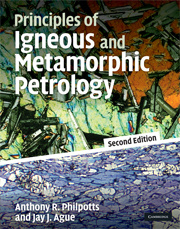Book contents
- Frontmatter
- Contents
- Preface
- Acknowledgments
- List of units
- 1 Introduction
- 2 Physical properties of magma
- 3 Intrusion of magma
- 4 Forms of igneous bodies
- 5 Cooling of igneous bodies and other diffusion processes
- 6 Classification of igneous rocks
- 7 Introduction to thermodynamics
- 8 Free energy and phase equilibria
- 9 Thermodynamics of solutions
- 10 Phase equilibria in igneous systems
- 11 Effects of volatiles on melt equilibria
- 12 Crystal growth
- 13 Isotope geochemistry related to petrology
- 14 Magmatic processes
- 15 Igneous rock associations
- 16 Metamorphism and metamorphic facies
- 17 Deformation and textures of metamorphic rocks
- 18 Graphical analysis of metamorphic mineral assemblages
- 19 Geothermometry, geobarometry, and mineral reactions among solid solutions
- 20 Mineral reactions involving H2O and CO2
- 21 Material transport during metamorphism
- 22 Pressure–temperature–time paths and heat transfer during metamorphism
- 23 Origin of rocks
- Answers to selected numerical problems
- References
- Index
22 - Pressure–temperature–time paths and heat transfer during metamorphism
- Frontmatter
- Contents
- Preface
- Acknowledgments
- List of units
- 1 Introduction
- 2 Physical properties of magma
- 3 Intrusion of magma
- 4 Forms of igneous bodies
- 5 Cooling of igneous bodies and other diffusion processes
- 6 Classification of igneous rocks
- 7 Introduction to thermodynamics
- 8 Free energy and phase equilibria
- 9 Thermodynamics of solutions
- 10 Phase equilibria in igneous systems
- 11 Effects of volatiles on melt equilibria
- 12 Crystal growth
- 13 Isotope geochemistry related to petrology
- 14 Magmatic processes
- 15 Igneous rock associations
- 16 Metamorphism and metamorphic facies
- 17 Deformation and textures of metamorphic rocks
- 18 Graphical analysis of metamorphic mineral assemblages
- 19 Geothermometry, geobarometry, and mineral reactions among solid solutions
- 20 Mineral reactions involving H2O and CO2
- 21 Material transport during metamorphism
- 22 Pressure–temperature–time paths and heat transfer during metamorphism
- 23 Origin of rocks
- Answers to selected numerical problems
- References
- Index
Summary
INTRODUCTION
Most metamorphic rocks have mineral assemblages that can be shown to have crystallized at elevated pressures and temperatures. With certain assemblages, these conditions can be specified quite closely using thermodynamic, kinetic, and experimental data. The important question that we must now address is: to what point in the history of a metamorphic rock do these conditions relate? The protoliths of many metamorphic rocks have their origins on the surface of Earth as sediment or lava. With burial, increasing pressure and temperature lead to the development of metamorphic minerals, which undergo successive changes as pressure and temperature continue to change. Then, through erosion and exhumation, the rocks return to Earth's surface. The rocks consequently undergo changes in pressure and temperature, which are both functions of time. The question, then, is: what part of this pressure–temperature–time (P–T–t) path is recorded in the final metamorphic rock?
The approach to equilibrium at one set of elevated temperature and pressure conditions is not always complete in metamorphic rocks, as evidenced by the presence of zoned minerals and overgrowths of one mineral on another (Fig. 22.1). The zoning in many porphyroblasts, in particular of aluminous minerals such as garnet, records ranges of pressure and temperature during the growth of the mineral. This information, in conjunction with P–T conditions indicated by the mineral assemblage of the rock, allows partial P–T–t paths to be constructed for some metamorphic rocks.
- Type
- Chapter
- Information
- Principles of Igneous and Metamorphic Petrology , pp. 560 - 583Publisher: Cambridge University PressPrint publication year: 2009



